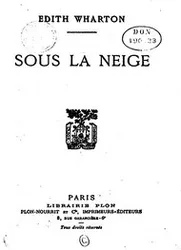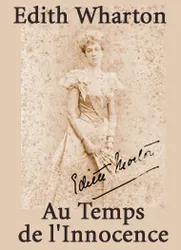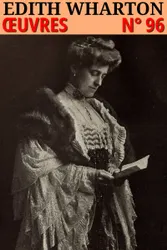The House of Mirth, a novel by Edith Wharton (1862–1937), tells the story of Lily Bart, a well-born but impoverished woman belonging to New York City's high society around the turn of the last century. Wharton creates a portrait of a stunning beauty who, though raised and educated to marry well both socially and economically, is reaching her 29th year, an age when her youthful blush is drawing to a close and her marital prospects are becoming ever more limited. The House of Mirth traces Lily's slow two-year social descent from privilege to a tragically lonely existence on the margins of society. Wharton uses Lily as an attack on "an irresponsible, grasping and morally corrupt upper class." Before publication as a book on October 14, 1905, The House of Mirth was serialized in Scribner's Magazine beginning in January 1905. It attracted a readership among housewives and businessmen alike. Charles Scribner wrote Edith in November 1905 that the novel was showing "the most rapid sale of any book ever published by Scribner." By the end of December sales had reached 140,000 copies. Edith's royalties were valued at more than half a million dollars in today's currency. The commercial and critical success of The House of Mirth solidified Wharton's reputation as a major novelist. Because of the novel's commercial success, some critics classified it as a genre novel. However, Edith's pastor, then rector of Trinity Church in Manhattan, wrote to tell her that her novel was "a terrible but just arraignment of the social misconduct which begins in folly and ends in moral and spiritual death." This moral purpose was not lost on the literary reviewers and critics of the time who tended to categorize it as both social satire and a novel of manners. Carol Singley in her Introduction to Edith Wharton's The House of Mirth: A Case Book states, "[The House of Mirth] is a unique blend of romance, realism, and naturalism,[and thus] transcends the narrow classification of a novel of manners."

The Greatest Feminist Classics in One Volume : Including 100+ Biographies & Memoirs of the Most Influential Women in History
Henrik Ibsen, Charlotte Brontë, Marietta Holley, Henry James, Louisa May Alcott, John Stuart Mill, Zona Gale, Jane Austen, Thomas Hardy, Edith Wharton, Gene Stratton-Porter, Rebecca Harding Davis, Margaret Fuller, Elizabeth Cady Stanton, Elia Wilkinson Peattie, Virginia Woolf, Mary Wollstonecraft, Willa Cather, Nathaniel Hawthorne, Mary Johnston, Grant Allen, Theodore Dreiser, Kate Chopin, Sojourner Truth, Charlotte Perkins Gilman, Harriet Martineau, Fanny Burney, Mary Ware Dennett, Julia Ward Howe, Ada Cambridge, H. G. Wells, Sarah H. Bradford, D. H. Lawrence, Nikolai Leskov, Lucy Maud Montgomery, Leo Tolstoy, Margaret Deland, Elizabeth Gaskell, Margaret Oliphant, Margaret Mitchell, Elizabeth von Arnim, Elizabeth Burgoyne Corbett
book
Library of Masterpieces - 100 Books to Read in a Lifetime
illiam Shakespeare, Fyodor Dostoevsky, Louisa May Alcott, Miguel de Cervantes, John Milton, Jane Austen, Charlotte Brontë, Emily Brontë, Anne Brontë, William Makepeace Thackeray, George Eliot, Charles Dickens, Thomas Hardy, Jonathan Swift, Daniel Defoe, Joseph Conrad, Robert Louis Stevenson, Mary Shelley, Bram Stoker, Arthur Conan Doyle, Wilkie Collins, Oscar Wilde, T. S. Eliot, D. H. Lawrence, James Joyce, Virginia Woolf, E. M. Forster, Evelyn Waugh, Aldous Huxley, George Orwell, H. G. Wells, Lewis Carroll, Frances Hodgson Burnett, Kenneth Grahame, C. S. Lewis, Malcolm Lowry, Ford Madox Ford, Mark Twain, Jack London, Herman Melville, Ernest Hemingway, Jack Kerouac, Nathaniel Hawthorne, Edith Wharton, Walt Whitman, Kate Chopin, Harriet Beecher Stowe, Neale Hurston, Richard Wright, Raymond Chandler, Dashiell Hammett, F. Scott Fitzgerald, John Steinbeck, William Faulkner, Margaret Mitchell, Sylvia Plath, Carson McCullers, L. Frank Baum, L. M. Montgomery, Leo Tolstoy, Ivan Turgenev, Nikolai Gogol, Johann Wolfgang von Goethe, Friedrich Nietzsche, Thomas Mann, Franz Kafka, Erich Maria Remarque, Albert Camus, Marcel Proust, Jules Verne, Victor Hugo, Gustave Flaubert, Stendhal, Alexandre Dumas, Henrik Ibsen, Rudyard Kipling, Homer, Sophocles, Virgil, Laozi, Sun Tzu, Plato, Marcus Aurelius, Dante Alighieri, Niccolò Machiavelli
book
Les metteurs en scène
Edith Wharton
book
Le Verdict
Edith Wharton
audiobook
Atrophie
Edith Wharton
audiobook
Sous la neige
Edith Wharton
audiobook
Au Temps de l'Innocence
Edith Wharton
audiobook
Learn French with Bilingual Books
Alexandre Dumas, Ambrose Gwinnett, Arthur Conan Doyle, Bram Stoker, Charles Dickens, Charles Kenneth Scott-Moncrieff, Charles Perrault, Charlotte Bronte, Daniel Defoe, Edgar Allan Poe, Edith Wharton, Emile Zola, Friedrich Wilhelm Nietzsche, Gustave Flaubert, Guy Maupassant, Hans Christian Andersen, Harriet Beecher Stowe, Herbert George Wells, Honoré de Balzac, Ivan Turgenev, James Fenimore Cooper, Jerome Klapka Jerome, Jules Verne, Leo Tolstoy, Lewis Carroll, Marcel Proust, Mark Twain, Mary Wollstonecraft Shelley, Maurice LeBlanc, Nikolai Gogol, Oscar Wilde, Prosper Mérimée, René Descartes, Robert Louis Stevenson, Victor Hugo, Voltaire, Walter Scott, William Shakespeare
book
Italian Villas and Their Gardens
Edith Wharton
book
Edith Wharton - Oeuvres : Classcompilé n° 96 - [5 romans dont Plein été, 9 nouvelles]
Edith Wharton
book
The Custom of the Country
Edith Wharton
audiobookbook
The Age of Innocence
Edith Wharton, The griffin classics
book
